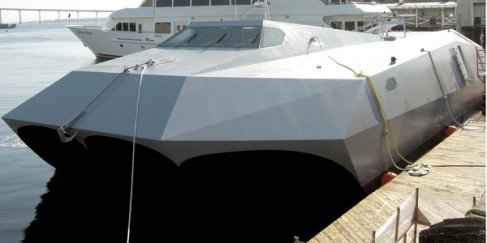
WASHINGTON, Jan. 31, 2006 – Speed and flexibility make a new military high-speed vessel especially valuable for shallow-water operations, a Defense Department official said.
The “Stiletto,” a shallow-water craft made of a tough, lightweight carbon composite material, offers a safer, more comfortable ride and is easily reconfigured to accommodate technological advances and the military’s needs, said Navy Cmdr. Greg E. Glaros, a transformation strategist in the Office of Force Transformation.
“We can’t predict the future,” Glaros said. “Therefore, . . . we better design systems that are . . . flexible. ”
Stiletto was initiated in the DoD transformation office in association with U. S. Special Operations Command, he said. When fielded, the boat will be available for use my all services. It’s meant to get special operations forces to their missions quickly with a top speed of more than 50 knots, Glaros said. Those forces, a total of 15 per boat, also could benefit from its unusual hull design.
Described as an “M-hull” because of its resemblance to the letter “M,” the water Stiletto displaces is pulled through tunnels under the boat. The water mixes with incoming air from the forward movement of the craft and creates an air cushion that the boat rides on, he said.
Glaros said this cushion could be a back-saving benefit for those using Stiletto for transport. The vertical impact to the neck and the spine from riding on a traditional small transport craft have been likened to a “10-G shock,” or the body suddenly weighing 10 times its own weight, at least twice an hour, he said. If a seat fails, that shock can spike to 20 Gs.
“At any given time, . . . 30 percent of (small boat-operating teams) are ‘medically down’ because of injuries sustained while driving their boats,” Glaros said. After about 10 years, most small-boat drivers are eligible for 100 percent disability by Department of Veterans Affairs standards, Glaros said.
Stiletto’s other purposes include what Glaros describes as “techno exploration. ” Basically, he said, the boat is a floating experiment. The office wanted to understand the uses and the limits of composite materials in this type of application.
The boat’s design also anticipates advances in technology, he said. “In our world today, the most powerful element is information,” Glaros said. “For us, it would be folly to build anything that didn’t have the means with which to connect to the outer world. ”
Stiletto’s “electronic keel” provides that connection, he said. The system offers open access to its network for various uses by all services, Glaros said. Its plug-and-play nature makes it adaptable to advancing technologies.
“It’ll (reduce) dramatically the cost of upgrades and, more importantly, it gives us options in the future so that we can change the mission and the configurations in the boat,” he said.
While any force can customize the hull for a specific purpose, Glaros said, it was designed with servicemembers in mind. “They’re at the heart of this,” he said. “Give them something that they can change and manipulate on their own and doesn’t damage them more than the enemy. ”
Fifteen months after the contract to build Stiletto was signed, the boat is considered “operational experimental,” Glaros said, though he is uncertain when it will be fielded. The boat will be put through its paces with Naval Special Clearance Team 1 in early May.
To date, the ship has cost about $12. 5 million, Glaros said. About one-fourth of that went to building computer-aided models and more operational testing.
.


This looks great, but what I really want to see is the plasma-coated tank. It images the scenery around it and portrays those images on the opposite side of the vehicle, rendering it nearly invisible, or permanently camoflauged while it moves.
Rhod I think I have lost my mind. hahaha
Maybe I dreamed this I don’t know. But I do remember what you are talking about. I think I even saw a photo of it someplace one time. I just looked in Google for 45 minutes and nothing came up.
I would love to see a photo of it.
There were articles about the windows on planes being plasma-coated and carried out in a vacum chamber by a robotic tool etc.
This is off subject but I know the love and respect you and those that comment here have for our military. I found this over at the Anti-Idotarian Rottweiler; a tasteless cartoon by Tom Tools which appeared in the Washington Post. He has linked a letter to the Post signed by all 5 of the Joint Chiefs condemning this cartoon.
http://www.nicedoggie.net/2006/?p=187#comments
Looks to me like boat riding is as rough on the body as riding in those tanks. I’d like to see something about a tank with that cammo scheme. Having been in M48 and M60 tanks I thought the Abrams was the hottest thing since sliced bread. I’m too old for that stuff any more, come to think of it I was too old for it back then. Armour is not the nicest place to be when the shooting starts, they need every advantage we can give them.
Bob, thank you for telling us and the link. I just got back from there and could only post two sentences, I am shaking I am so angry.
I am going to do a post on here about it now on here and I thank you so much for letting us know about it.
Hi Jack thank you for sharing about the M48 and M60 tanks and the Abrams. I agree our troops need every advantage we can give them. Thank you for commenting.